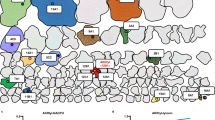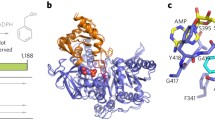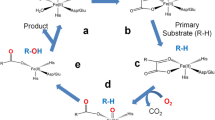Abstract
The aldo-keto reductases (AKR) comprise a large family of oxidoreductases with importance to both health and industrial applications. The redox chemistry of the AKRs is dependent on NAD(P)H as a cofactor. Despite a wealth of structural and biochemical data relating to the interaction of AKRs with specific inhibitors, much less is known regarding the interactions with cofactor or substrate. In particular, while many X-ray structures are available for AKR/inhibitor complexes, they are only a few examples where apo- and holo-forms can be directly compared. Thus, while the role of the cofactor in the redox chemistry is generally understood, the details of the structural dynamics associated with cofactor binding are less clear. Likewise, the structural details of both cofactor and substrate specificity are limited. In this review, we focus on details of the structural biology and molecular dynamics associated with catalysis, cofactor, and substrate binding as elucidated for those AKRs for which apo- and holo-structures are available. Understanding such dynamics may identify a new direction in the design of specific inhibitors.
Similar content being viewed by others
References
Jez, J. M., Flynn, T. G., and Penning, T. M. (1997) A nomenclature system for the aldo-keto reductase superfamily. Adv. Exp. Med. Biol. 414, 579–600.
Jez, J. M., Flynn, T. G., and Penning, T. M. (1997) A new nomenclature for the aldo-keto reductase superfamily. Biochem. Pharm. 54, 639–647.
Welle, R., Schroder, G., Schiltz, E., Grisebach, H., and Schroder, J. (1991) Induced plantresponses to pathogen attack—analysis and heterologous expression of the key enzyme in the biosynthesis of phytoalexins in soybean (glycine-max L merr cv harosoy-63). Eur. J. Biochem. 196, 423–430.
Bruce, N. C., Willey, D. L., Coulson, A. F., and Jeffery, J. (1994) Bacterial morphine dehydrogenase further defines a distinct superfamily of oxidoreductases with diverse functional activities. Biochem. J. 299, 805–811.
Wilson, D. K., Nakano, T., Petrash, J. M., and Quiocho, F. A. (1995) 1.7 Å Structure of FR-1, a fibroblast growth factor induced member of the aldo-keto reductase family complexed with coenzyme and inhibitor. Biochemistry 34, 14,323–14,330.
Penning, T. M., Pawlowski, J. E., Schlegel, B. P., et al. (1996) Mammalian 3 alpha-hydroxysteroid dehydrogenases. Steroids 61, 508–523.
Kador, P. F. and Kinoshita, J. H. (1984) Diabetic and galactosaemic cataracts. Ciba Found Symp. 106, 110–131.
Kinoshita, J. H. and Nishimura, C. (1988) The involvement of aldose reductase in diabetic complications. Diabetes Metab. Rev. 4, 323–337.
Turner, A. J. and Tipton, K. F. (1972) The characterization of two reduced nicotinamide-adenine dinucleotide phosphate-linked aldehyde reductases from pig brain. Biochem. J. 130, 765–772.
Penning, T. M. and Talalay, P. (1983) Inhibition of a major NAD(P)-linked oxidoreductase from rat liver cytosol by steroidal and nonsteroidal anti-inflammatory agents and by prostaglandin Proc. Natl. Acad. Sci. USA 80, 4304–4308.
Anderson, S., Marks, C. B., Lazarus, R., et al. (1985) Production of 2-keto-l-gulonate, an intermediate in l-ascorbate synthesis, by a genetically modified. Erwinia herbicola. Science 230, 144–149.
Grindley, J. F., Payton, M. A., van de Pol, H., and Hardy, K. G. (1988) Conversion of glucose to 2-keto-l-gulonate, an intermediate in L-ascorbate synthesis, by a recombinant strain of Erwinia citreus. Appl. Environ. Microbiology 54, 1770–1775.
Khurana, S., Powers, D. B., Anderson, S., and Blaber, M. (1998) Crystal structure of 2,5-diketo-d-gluconic acid reductase A complexed with NADPH at 2.1 Å resolution. Proc. Natl. Acad. Sci. USA 95, 6768–6773.
el-Kabbani, O., Judge, K., Ginell, S. L., Myles, D. A., DeLucas, L. J., and Flynn, T. G. (1995) Structure of porcine aldehyde reductase holoenzyme. Nat. Struct. Biol. 2, 687–692.
Flynn, T. G., Green, N. C., Bhatia, M. B., and el-Kabbani, O. (1995) Structure and mechanism of aldehyde reductase. Adv. Exp. Med. Biol. 372, 193–201.
Rondeau, J. M., Tete-Favier, F., Podjarny, A., et al. (1992) Novel NADPH-binding domain revealed by the crystal structure of aldose reductase. Nature 355, 469–472.
Wilson, D. K., Bohren, K. M., Gabbay, K. H., and Quiocho, F. A. (1992) An unlikely sugar substrate site in the 1.65 Å structure of the human aldose reductase holoenzyme implicated in diabetic complications. Science 257, 81–84.
Ye, Q., Hyndman, D., Li, X., Flynn, T. G., and Jia, Z. (2000) Crystal structure of CHO reductase, a member of the aldo-keto reductase superfamily. Proteins 38, 41–48.
Hoog, S. S., Pawlowski, J. E., Alzari, P. M., Penning, T. M., and Lewis, M. (1994) Three-dimensional structure of rat liver 3α-hydroxysteroid/dihydrodiol dehydrogenase: a member of the aldo-keto reductase superfamily. Proc. Natl. Acad. Sci. USA 91, 2517–2521.
Sanli, G. and Blaber, M. (2001) Structural assembly of the active site in an aldo-keto reductase by NADPH cofactor. J. Mol. Biol. 309, 1209–1218.
Gulbis, J. M., Mann, S., and MacKinnon, R. (1999) Structure of a voltage-dependent K+ channel beta subunit. Cell 97, 943–952.
Kavanagh, K. L., Klimacek, M., Nidetzky, B., and Wilson, D. K. (2002) The structure of apo and holo forms of xylose reductase, a dimeric aldo-keto reductase from Candida tenuis. Biochemistry 41, 8785–8795.
Jez, J. M., Bennett, M. J., Schlegel, B. P., Lewis, M., and Penning, T. M. (1997) Comparative anatomy of the aldo-keto reductase superfamily. Biochem. J. 326, 625–636.
Kubiseski, T. J., Hyndman, D. J., Morjana, N. A., and Flynn, T. C. (1992) Studies on pig muscle aldose reductase: kinetic mechanism and evidence for a slow conformational change upon coenzyme binding. J. Biol. Chem. 267, 6510–6517.
Grimshaw, C. E., Shahbaz, M., and Putney, C. G. (1990) Mechanistic basis for non-linear kinetics of aldehyde reduction catalyzed by aldose reductase. Biochemistry 29, 9947–9955.
Borhani, D. W., Harter, T. M., and Petrash, J. M. (1992) The crystal structure of the aldose reductase: NADPH binary complex. J. Biol. Chem. 267, 24,841–24,847.
el-Kabbani, O., Wilson, D. K., Petrash, M., and Quiocho, F. A. (1998) Structural features of the aldose reductase and aldehyde reductase inhibitor-binding sites. Mol. Vis. 4, 19.
Urzhumtsev, A., Tete-Favier, F., Mitschler, A. et al. (1997) A “specificity” pocket inferred from the crystal structures of the complexes of aldose reductase with the pharmaceutically important inhibitors tolrestat and sorbinil. Structure 5, 601–612.
Banner, D. W., Bloomer, A. C., Petsko, G. A., et al. (1975) Structure of chicken muscle triose phosphate isomerase determined crystallographically at 2.5 angstrom resolution using amino acid sequence data. Nature 255, 609–614.
Farber, G. K. and Petsko, G. A. (1990) The evolution of α/β barrel enzymes. Trends Biochem. Sci. 15, 228–234.
Branden, C.-I. (1991) The TIM barrel—the most frequently occurring folding motif in proteins. Curr. Opin. Struct. Biol. 1, 978–983.
Copley, R. R. and Bork, P. (2000) Homology among (betaalpha)(8) barrels: implications for the evolution of metabolic pathways. J. Mol. Biol. 303, 627–641.
el-Kabbani, O., Green, N. C., Lin, G. D., et al. (1994) Structures of human and porcine aldehyde reductase—an enzyme implicated in diabetic complications. Acta Crystallogr. D: Biol. Crystallogr. 50, 859.
Yoshida, M., Kuroki, Y., Kobayashi, E., and Tamaoki, B. (1992) Kinetic mechanism of reduction of testosterone by hepatic 5-beta-reductase of chicken and inhibition of the reductase-activity by a secosteroid, an azasteroid and glycyrrhetinic acid. J. Steroid Biochem. Mol. Biol. 41, 29–36.
Davidson, W. S. and Flynn, T. G. (1979) Kinetics and mechanism of action of aldehyde reductase from pig kidney. Biochem. J. 177, 595–601.
Askonas, L. J., Ricigliano, J. W., and Penning, T. M. (1991) The kinetic mechanism catalysed by homogeneous rat liver 3 alpha-hydroxysteroid dehydrogenase. Evidence for binary and ternary dead-end complexes containing nonsteroidal anti-inflammatory drugs. Biochem. J. 278, 835–841.
Harrison, D. H., Bohren, K. M., Ringe, D., Petsko, G. A., and Gabbay, K. H. (1994) An anion binding site in human aldose reductase: Mechanistic implications for the binding of citrate, cacodylate, and glucose 6-phosphate. Biochemistry 33, 2011–2020.
Boghosian, R. A. and McGuinness, E. T. (1981) Pig brain aldose reductase: a kinetic study using the centrifugal fast analyzer. Int. J. Biochem. 13, 909–914.
Ryle, C. M. and Tipton, K. F. (1985) Kinetic studies with the low-Km aldehyde reductase from ox brain. Biochem. J. 227, 621–627.
Schlegel, B. P., Jez, J. M., and Penning, T. M. (1998) Mutagenesis of 3 alpha-hydroxysteroid dehydrogenase reveals a “push-pull” mechanism for proton transfer in aldo-keto reductases. Biochemistry 37, 3538–3548.
Bennett, M. J., Schlegel, B. P., Jez, J. M., Penning, T. M., and Lewis, M. (1996) Structure of 3 alpha-hydroxysteroid/dihydrodiol dehydrogenase complexed with NADP+. Biochemistry 35, 10,702–10,711.
Bennett, M. J., Albert, R. H., Jez, J. M., Ma, H., Penning, T. M., and Lewis, M. (1997) Steroid recognition and regulation of hormone action: crystal structure of testosterone and NADP+ bound to 3 alpha-hydroxysteroid/dihydrodiol dehydrogenase. Structure 5, 799–812.
Wilson, D. K., Tarle, I., Petrash, J. M., and Quiocho, F. A. (1993) Refined 1.8 A structure of human aldose reductase complexed with the potent inhibitor zopolrestat. Proc. Natl. Acad. Sci USA 90, 9847–9851.
Bohren, K. M., Bullock, B., Wermuth, B., and Gabbay, K. H. (1989) The aldo-keto reductase superfamily. cDNAs and deduced amino acid sequence of human aldehyde and aldose reductases. J. Biol. Chem. 264, 9547–9551.
Bohren, K. M. and Gabbay, K. H. (1993) Cys298 is responsible for reversible thiol-induced variation in aldose reductase activity. Adv. Exp. Med. Biol. 328, 267–277.
Petrash, J. M., Harter, T., Tarle, I., and Borhani, D. (1993) Kinetic alteration of human aldose reductase by mutagenesis of cysteine residues. Adv. Exp. Med. Biol. 328, 289–300.
Liu, S. Q., Bhatnagar, A., and Srivastava, S. K. (1993) Bovine lens aldose reductase. pH-dependence of steady-state kinetic parameters and nucleotide binding. J. Biol. Chem. 268, 25,494–25,499.
Bohren, K. M., Grimshaw, C. E., Lai, C.-J., et al. (1994) Tyrosine-48 is the proton donor and histidine-110 directs substrate stereochemical selectivity in the reduction of human aldose reductase: enzyme kinetics and crystal structure of the Y48H mutant enzyme. Biochemistry 33, 2021–2032.
Barski, O. A., Gabbay, K. H., and Bohren, K. M. (1996) The C-terminal loop of aldehyde reductase determines the substrate and inhibitor specificity. Biochemistry 35, 14,276–14,280.
Tarle, I., Borhani, D. W., Wilson, D. K., Quiocho, F. A., and Petrash, J. M. (1993) Probing the active site of human aldose reductase. Sitedirected mutagenesis of Asp-43, Tyr-48, Lys-77, and His-110. J. Biol. Chem. 268, 25,687–25,693.
Khurana, S., Sanli, G., Powers, D. B., Anderson, S., and Blaber, M. (2000) Molecular modeling of substrate binding in wild-type and mutant Corynebacteria 2,5-diketo-d-gluconate reductases. PROT: Struct. Funct. Genet. 39, 68–75.
Varnai, P., Richards, W. G., and Lyne, P. D. (1999) Modelling the catalytic reaction in human aldose reductase. Proteins 37, 218–227.
Dubois, J., Chapman, S. K., Mathews, F. S., Reid, G. A., and Lederer, F. (1990) Substitution of Tyr254 with Phe at the active site of flavocytochrome b2: consequences on catalysis of lactate dehydrogenase. Biochemistry 29, 6393–6400.
Barski, O. A., Gabbay, K. H., Grimshaw, C. E., and Bohren, K. M. (1995) Mechanism of human aldehyde reductase: characterization of the active site pocket. Biochemistry 34, 11,264–11,275.
Pawlowski, J. E. and Penning, T. M. (1994) Overexpression and mutagenesis of the cDNA for rat liver 3α-hydroxysteroid/dihydrodiol dehydrogenase. J. Biol. Chem. 269, 13,502–13,510.
Carper, D. A., Hohman, T. C., and Old, S. E. (1995) Residues affecting the catalysis and inhibition of rat lens aldose reductase. Biochim. Biophys. Acta 1246, 67–73.
Klimacek, M., Szekely, M., Griessler, R., and Nidetzky, B. (2001) Exploring the active site of yeast xylose reductase by site-directed mutagenesis of sequence motifs characteristic of two dehydrogenase/reductase family types. FEBS Lett. 500, 149–152.
Grimshaw, C. E., Bohren, K. M., Lai, C. J., and Gabbay, K. H. (1965) Human aldose reductase: pK of tyrosine 48 reveals the preferred ionization state for catalysis and inhibition. Biochemistry 34, 14,374–14,384.
Grimshaw, C. E., Bohren, K. M., Lai, C. J., and Gabbay, K. H. (1995) Human aldose reductase: subtle effects revealed by rapid kinetic studies of the C298A mutant enzyme. Biochemistry 34, 14,366–14,373.
Grimshaw, C. E., Bohren, K. M., Lai, C. J., and Gabbay, K. H. (1995) Human aldose reductase: rate constants for a mechanism including interconversion of ternary complexes by recombinant wild-type enzyme. Biochemistry 34, 14,356–14,365.
Ye, Q., Hyndman, D., Green, N. C., Li, L., Jia, Z., and Flynn, T. G. (2001) The crystal structure of an aldehyde reductase Y50F mutant-NADP complex and its implications for substrate binding. Chem. Biol. Interact. 130–132, 651–658.
Ehrig, T., Bohren, K. M., Prendergast, F. G., and Gabbay, K. H. (1994) Mechanism of aldose reductase inhibition: binding of NADP+/NADPH and alrestatin-like inhibitors. Biochemistry 33, 7157–7165.
Wermuth, B. and von Wartburg, J. P. (1982) Aldose reductase from human tissues. Methods Enzymol. 89, 181–186.
Worrall, D. M., Daly, A. K., and Mantle, T. J. (1986) Kinetic studies on the major form of aldehyde reductase in ox kidney: a general kinetic mechanism to explain substrate-dependent mechanisms and the inhibition by anticonvulsants. J. Enzyme Inhib. 1, 163–168.
Tipton, K. F. and Ryle, C. M. (1985) Some properties of the “low-Km” aldehyde reductase from ox brain. Prog. Clin. Biol. Res. 174, 241–250.
Grimshaw, C. E., Shahbaz, M., Jahangiri, G., Putney, C. G., McKercher, S. R., and Mathur, E. J. (1989) Kinetic and structural effects of activation of bovine kidney aldose reductase. Biochemistry 28, 5343–5353.
De Jongh, K. S., Schofield, P. J., and Edwards, M. R. (1987) Kinetic mechanism of sheep liver NADPH-dependent aldehyde reductase. Biochem. J. 242, 143–150.
Bohren, K. M., Grimshaw, C. E., and Gabbay, K. H. (1992) Catalytic effectiveness of human aldose reductase. J. Biol. Chem. 267, 20,965–20,970.
Hur, E. and Wilson, D. K. (2001) The crystal structure of the GCY1 protein from S. cerevisiae suggests a divergent aldo-keto reductase catalytic mechanism. Chem. Biol. Interact. 130–132, 527–536.
Ma, H., Ratnam, K., and Penning, T. M. (2000) Mutation of nicotinamide pocket residues in rat liver 3 alpha-hydroxysteroid dehydrogenase reveals different modes of cofactor binding. Biochemistry 39, 102–109.
Kubiseski, T. J. and Flynn, T. G. (1995) Studies on human aldose reductase: probing the role of arginine 268 by site directed mutagenesis. J. Biol. Chem. 270, 16,911–16,917.
Powers, D. P. 1996. In Structure/function studies of 2,5-diketo-d-gluconic acid reductases. Thesis, University of Medicine and Dentistry of New Jersey, Piscataway, NJ, p. 163.
Karplus, P. A. and Schulz, G. E. (1987) Refined structure of glutathione reductase at 1.54 A resolution. J. Mol. Biol. 195, 701–729.
Bohren, K. M., Page, J. L., Shankar, R., Henry, S. P., and Gabbay, K. H. (1991) Expression of human aldose and aldehyde reductases. Sitedirected mutagenesis of a critical lysine 262. J. Biol. Chem. 266, 24,031–24,037.
Hayward, S. and Berendsen, H. J. C. (1998) Systematic analysis of domain motions in proteins from conformational changew; new results on citrate synthase, and T4 lysozyme. PROT: Struct. Funct. Genet. 30, 144–154.
Kubiseski, T. J., Green, N. C., Borhani, D. W., and Flynn, T. G. (1994) Studies on pig aldose reductase. Identification of an essential arginine in the primary and tertiary structure of the enzyme. J. Biol. Chem. 269, 2183–2188.
Banta, S., Swanson, B. A., Wu, S., Jarnagin, A., and Anderson, S. (2002) Optimizing an artificial metabolic pathway: engineering the cofactor specificity of Corynebacterium 2,5-diketo-d-gluconic acid reductase for use in vitamin C biosynthesis. Biochemistry 41, 6226–6236.
Banta, S., Swanson, B. A., Wu, S., Jarnagin, A., and Anderson, S. (2002) Alteration of the specificity of the cofactor-binding pocket of Corynebacterium 2,5-diketo-d-gluconic acid reductase A. Proc. Eng. 15, 131–140.
Author information
Authors and Affiliations
Corresponding author
Rights and permissions
About this article
Cite this article
Sanli, G., Dudley, J.I. & Blaber, M. Structural biology of the aldo-keto reductase family of enzymes. Cell Biochem Biophys 38, 79–101 (2003). https://doi.org/10.1385/CBB:38:1:79
Issue Date:
DOI: https://doi.org/10.1385/CBB:38:1:79




